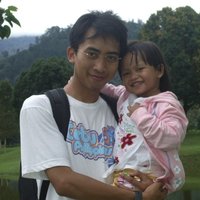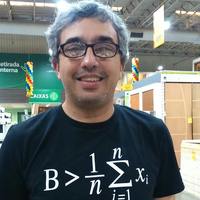Papers by DANTON DIEGO FERREIRA
Procedings do XXII Congresso Brasileiro de Automatica, Oct 18, 2022
Procedings do XXII Congresso Brasileiro de Automatica, Oct 18, 2022
Procedings do XXII Congresso Brasileiro de Automatica, Oct 18, 2022
Measurement, Nov 1, 2018
It is known that the quality of power has been the subject of several researches aiming to provid... more It is known that the quality of power has been the subject of several researches aiming to provide relevant information to users of electrical systems that are becoming increasingly smart. This study presents an approach for single and multiple power quality disturbance detection and classification using multidimensional analysis, higher-order statistics and a neuro-tree based classifier. The system was implemented in an FPGA (Field Programmable Gate Array), a real-time processor and a remote computer, with LabVIEW interface. This implementation enables real-time execution and its application to monitor smart grids. It is able to detect deviations in the measured voltage waveform from the nominal one and classify 20 classes of single and multiple disturbances with a global efficiency upper to 97%.

IGI Global eBooks, 2020
This paper is aimed to present a displacement measurements technique which was performed automati... more This paper is aimed to present a displacement measurements technique which was performed automatically in a cantilever beam using a robotic arm manipulator. This technique is based on the difference of measured coordinates of the robotic arm manipulator in order to provide displacement results. The robotic arm was supported by a micro-switch sensor which in contact with a sample, measured 21x3 points distributed along the sample. Measurements were performed before and after adding the loads on the free end of the cantilever beam, manufactured in ASTM A36 steel. Experiments were performed through loads of 1.96 N, 4.9 N, 9.8 N and 19.6 N using the robotic manipulator controller. Ten sets of measurement were performed for each load. The average and standard deviation for each set of points were also performed. Results were compared to Finite Element Method (FEM) simulations in order to verify the accuracy of the proposed compared to FEM results. Sum of squared errors presented values lower than 3% demonstrating the potentiality of the proposed technique for industries application.

Theoretical and Applied Engineering, Apr 27, 2020
This paper is aimed to analyze vibrations from engines fueled with two different fuels, Brazilian... more This paper is aimed to analyze vibrations from engines fueled with two different fuels, Brazilian commercial diesel (B8) and Biodiesel (B100). Consumption, level of particulate matter emissions and engine temperature were also analyzed. The experiments were performed considering noninvasive tests in a diesel engine, taking into account three different speeds: 800 rpm, 1800 rpm and 3600 rpm. Results showed that the engine energetic loss from vibration signals collected allowed a quantitative assessment of how each fuel influenced the engine vibration level. In the three analyzed speeds, B8 diesel fuel showed be more energetic when compared to B100 biodiesel fuel. Although the consumption using B100 biodiesel fuel presented higher values than B8, the level of particulate matter emissions was lower than commercial diesel B8. It was also noted that the vibration increased in both cases when the engine speed increased. B8 diesel presented a total vibration varying according to speeds range, from 4.5% to 21% higher than B100 biodiesel. Therefore, the dissipated vibration energy using B8 diesel was higher (10% to 45%) than B100 biodiesel. It is concluded that combustion is one of the item that generates higher level of vibration in diesel engines and it depends on the kind of fuel used.

PLOS ONE, Jul 13, 2023
Background and objective Diabetes Mellitus (DM) is a chronic disease with a high worldwide preval... more Background and objective Diabetes Mellitus (DM) is a chronic disease with a high worldwide prevalence. Diabetic foot is one of the DM complications and compromises health and quality of life, due to the risk of lower limb amputation. This work aimed to build a risk classification system for the evolution of diabetic foot, using Artificial Neural Networks (ANN). Methods This methodological study used two databases, one for system design (training and validation) containing 250 participants with DM and another for testing, containing 141 participants. Each subject answered a questionnaire with 54 questions about foot care and sociodemographic information. Participants from both databases were classified by specialists as high or low risk for diabetic foot. Supervised ANN (multi-layer Perceptron-MLP) models were exploited and a smartphone app was built. The app returns a personalized report indicating self-care for each user. The System Usability Scale (SUS) was used for the usability evaluation. Results MLP models were built and, based on the principle of parsimony, the simplest model was chosen to be implemented in the application. The model achieved accuracy, sensitivity, specificity, positive predictive value, and negative predictive value of 85%, 76%, 91%, 89%, and 79%, respectively, for the test data. The app presented good usability (93.33 points on a scale from 0 to 100). Conclusions The study showed that the proposed model has satisfactory performance and is simple, considering that it requires only 10 variables. This simplicity facilitates its use by health professionals and patients with diabetes.
Smart agricultural technology, Aug 1, 2023

Congresso Brasileiro de Automática - CBA, 2019
Recentemente, emissoes na faixa de frequencia de 2 kHz a 150 kHz, referida como faixa supraharmon... more Recentemente, emissoes na faixa de frequencia de 2 kHz a 150 kHz, referida como faixa supraharmonica, tornou-se objeto de estudo da comunidade pesquisadora em Qualidade de Energia Eletrica (QEE). A maioria dos monitores de QEE comerciais nao estao habilitados ao acesso desta alta frequencia sem atualizacao de hardware e software para processadores mais complexos e conversor analogico digital. O foco deste trabalho e apresentar uma tecnica de analise de distorcoes supraharmonicas que possibilita o uso dos monitores dos QEE existentes sem modificacao significativa de hardware e software. A tecnica e baseada na utilizacao de um banco de filtros analogicos e aplicacao de subamostragem. O uso da tecnica de subamostragem permite a reducao do numero de amostras processadas pela FFT (Fast Fourier Transform). Atraves de uma analise sistematica, verificou-se que a metodologia proposta apresenta reduzida complexidade computacional.

Anais do 14º Simpósio Brasileiro de Automação Inteligente, 2019
Widely, researchers are now turning their attention to Electrical Energy Quality (EEQ), due to un... more Widely, researchers are now turning their attention to Electrical Energy Quality (EEQ), due to unwanted disturbs on electrical signals, caused mostly by the increasing applications of power electronics. This paper introduces a EEQ's classify system. To classify these disturbs was used a One Class Support Vector Machine. Superior Order Statistics (SOS) based parameters were extracted from tension signals to be detected and classified. After that, Fisher discrimination ratio was used to select and pick the fittest parameters. Once they were taken, possibles simplifications are done on algorithm and decent results were achieved. Resumo: Em grande escala a atenção de pesquisadores tem sido direcionada à Qualidade de Energia Elétrica (QEE), devido as indesejadas interferências sofridas pelo sinal elétrico causadas pela ampla e crescente utilização da eletrônica de potência. Este trabalho apresenta um sistema para classificar distúrbios de qualidade de energia elétrica (QEE). Para realização da classificação foi feito uso da chamada Máquina de Vetor de Suporte one class. Parâmetros baseados em Estatística de Ordem Superior (EOS) foram extraídos dos sinais de tensão para serem apresentados ao detector e classificador. A razão de discriminação de Fisher foi aplicada para selecionar os parâmetros mais relevantes. Uma vez obtidos os melhores parâmetros e realizadas as possíveis simplificações no algoritmo de classificação, resultados satisfatórios foram alcançados.
Measurement, 2015
A denoising technique for single channel data is proposed. By assuming the observed signal to be ... more A denoising technique for single channel data is proposed. By assuming the observed signal to be the mixture of two unknown uncorrelated sources, an expression for the principal components (PC) of the set constituted by the signal and its k-sample delayed version is derived. The expression does not require matrix manipulations and may be hence useful when both speed and memory usage are crucial. The second PC was found to be a suitable estimate of one of the sources. Illustrations are provided for a simulated voltage signal corrupted by harmonics and transient disturbances as well as for a real electromyographic signal with electrocardiographic interference. A comparison with a standard, wavelet-based method for denoising is also provided.

Fontes alternativas de energia surgiram pela necessidade de se resolver problemas ambientais, lid... more Fontes alternativas de energia surgiram pela necessidade de se resolver problemas ambientais, lidar com o aumento dos precos da energia e tambem com os custos de manutencao e construcao de usinas. Tais fontes alternativas, que integram a geracao distribuida, tambem trouxeram alguns problemas antes inexistentes para o sistema eletrico de potencia. Um dos problemas gerados pela utilizacao de geracoes distribuidas _e o surgimento de ilamentos nao programados, gerados por falhas adversas no sistema eletrico de potencia. Este fenomeno pode por exemplo, resultar em ferimentos graves para os tecnicos que estao tentando resolver o problema de falta de energia, e tambem gerar problemas tecnicos no sistema eletrico. Nesse contexto, o presente trabalho para deteccao de filamentos nao intencionais utiliza ICA para realizar tal deteccao. Utilizando recursos baseados em estatisticas de ordem superior, foi possivel detectar filamentos, assim como classificar os eventos associados a geracao distribuida, com taxas de 100 % de acertos para ilhamento.

The study of the area of Power Quality (PQ) has grown recently. The increasing use of high power ... more The study of the area of Power Quality (PQ) has grown recently. The increasing use of high power converters and of nonlinear loads cause changes in the electrical signal (current and voltage), which are often called disturbances. This work presents a system to detect disturbances of PQ based on a neural NARX model (Nonlinear Autoregressive with eXogenous inputs). From the application of a notch filter on the voltage signal, the neural network estimates the signal value one step ahead and, through the residue analysis of this model, the disturbance is detected. The system was tested on simulations of six classes of disturbances, with different signal-to-noise ratios and variations of the fundamental frequency, showing a very high detection accuracy using few samples of the event with disturbance. Resumo: O estudo daárea de Qualidade de Energia Elétrica (QEE) tem crescido muito noś ultimos anos. O aumento no uso de conversores de alta potência e de cargas não lineares com potência elevada causam perturbações no sinal elétrico (corrente e tensão), chamadas de distúrbios. Este trabalho apresenta um sistema de detecção de distúrbios de qualidade da energia elétrica (QEE) baseado em um modelo neural NARX (Nonlinear Autoregressive with eXogenous inputs). A partir da aplicação de um filtro notch no sinal de tensão, a rede neural estima o valor do sinal um passoà frente e, por meio da análise de resíduo deste modelo, o distúrbió e detectado. O sistema foi testado em simulações de seis classes de distúrbios, com diferentes relações sinal-ruído e variações na frequência fundamental, apresentando um acerto de detecção bastante elevando utilizando poucas amostras do evento com distúrbio.

Procedings do XXII Congresso Brasileiro de Automatica, 2018
O crescente numero de cargas poluidoras ligadas a rede eletrica impulsiona pesquisas na area de q... more O crescente numero de cargas poluidoras ligadas a rede eletrica impulsiona pesquisas na area de qualidade de ener-gia eletrica. Tal poluicao se mostra visivel como deformidades na forma de onda de tensao, dentre as quais se destacam os sags. Este trabalho visa a deteccao do momento da ocorrencia do disturbio por meio de Analise de Componentes Independentes. De posse de tal informacao, o sistema segmenta o sinal eletrico para que possa ser processado por meio de estatisticas de ordem su-perior. As informacoes obtidas por tal processo sao usadas para classificacao automatica de causas do sag trifasico – faltas, partida de motores de inducao e energizacao de transformadores por meio de uma Maquina de Vetores Suporte multiclasses. O sistema foi desenvolvido em LabVIEW e seu desempenho foi avaliado de forma off-line e por meio de um sistema integrado de aquisicao de dados, alcancando uma eficiencia global de 96,7%.
Procedings do XXII Congresso Brasileiro de Automatica, 2018
Procedings do XXII Congresso Brasileiro de Automatica, 2018

Procedings do XXII Congresso Brasileiro de Automatica, 2018
Sendo uma generalizacao nao linear de analise de componentes principais a tecnica de curvas princ... more Sendo uma generalizacao nao linear de analise de componentes principais a tecnica de curvas principais e um ferramenta robusta para analise e classificacao de dados. Em reconhecimento de padroes um dos algoritmos mais populares para construcao de Curvas Principais e o algoritmo k-segmentos. Esse algoritmo apresenta bons resultados e otima aplicabilidade por sua convergencia garantida e robustez. Contudo, sua utilizacao depende de parâmetros definidos pelo usuario. Este trabalho apresenta uma tecnica de selecao automatica da quantidade e comprimento dos segmentos do algoritmo de k-segmentos com a utilizacao da meta-heuristica TLBO (Teaching-Learning-Based Optimization). E utilizada uma funcao-custo que leva em consideracao o comprimento da curva e a distância dos eventos aos segmentos onde se projetam. Testes experimentais feitos com bases de dados sinteticos sao apresentados para demonstrar a eficiencia do metodo proposto em problemas de representacao.
Procedings do XXII Congresso Brasileiro de Automatica, 2018
In this work a new method for data clustering based on principal curves is presented. Principal c... more In this work a new method for data clustering based on principal curves is presented. Principal curves consist of a nonlinear generalization of Principal Component Analysis and may also be regarded as continuous versions of 1-D self-organizing maps. The proposed method divides the principal curves extracted by the k-segments algorithm into two or more curves, according to the number of clusters defined by the user. Then, the data are grouped according to the short distance from them to the curves. The method was applied to eight databases with different characteristics. The results were compared with the k-means algorithm. The method shown to be suitable for elongated and spherical clusters.

IEEE Latin America Transactions, May 1, 2018
Identification of people by face is the most effective non-intrusive method in biometry. However,... more Identification of people by face is the most effective non-intrusive method in biometry. However, it is a great challenge for researchers because faces are complex and multidimensional. In addition, high level of difficulty is added by changes in illumination and/or pose. In this work, a face recognition method based on Higher-Order Statistics (HOS) is proposed. HOS has the important signal processing properties of: (i) handling colored Gaussian measurement noise more efficiently, (ii) extracting information due to deviations from Gaussianity, and (iii) detecting and characterizing nonlinear properties in signals. In this work, features based on HOS are used to build compact signature of faces. It is considered a Public Security scenario where the goal is to detect and identify individuals with criminal links, previously registered in a database. To select the most discriminant HOS-based features, the Fisher's Discriminant Ratio (FDR) was used and the linear correlation was applied to eliminate redundancy. Three classifiers (the Bayesian, Support Vector Machines (SVM) and the K-nearest neighbor (KNN)) were employed for final classification and their performances were compared. For performance evaluation, images from ORL dataset were used. The results showed detection and classification rates over 70% and indicates the potential of HOS on building face signatures.











Uploads
Papers by DANTON DIEGO FERREIRA